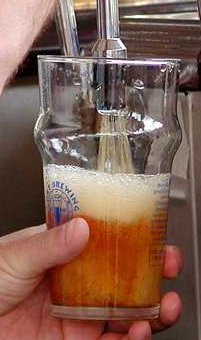Beer engine
Beer Engine[edit | edit source]
A beer engine is a device for pumping beer from a cask, usually located in a cellar, to the bar. It is a type of hand pump that is manually operated by a bartender, also known as a publican. The beer engine is a crucial component in the traditional serving of cask ale, allowing for the beer to be served without the use of additional carbon dioxide pressure.
History[edit | edit source]
The beer engine was invented by John Lofting, a Dutch inventor, in the late 17th century. It was further developed and popularized in the 18th century by Joseph Bramah, who patented a more efficient version in 1797. The introduction of the beer engine revolutionized the way beer was served, allowing for a more consistent and controlled pour.
Operation[edit | edit source]
The beer engine operates by creating a vacuum that draws beer up from the cask through a flexible tube. The bartender pulls a handle, which activates a piston inside the cylinder of the engine. This action draws the beer up and out through the spout, often passing through a device called a sparkler. The sparkler aerates the beer, creating a creamy head and enhancing the aroma.
Components[edit | edit source]
A typical beer engine consists of several key components:
- Handle: The lever that the bartender pulls to operate the pump.
- Cylinder and Piston: The mechanism that creates the vacuum to draw the beer.
- Nozzle: The spout from which the beer is dispensed.
- Sparkler: An optional attachment that aerates the beer.
Types of Beer Engines[edit | edit source]
Beer engines can vary in design and operation. Some are mounted directly on the bar, while others are installed below the bar with only the handle visible. The choice of beer engine can affect the presentation and taste of the beer, with some purists preferring engines without sparklers for a more traditional experience.
Usage[edit | edit source]
Beer engines are predominantly used in the United Kingdom, where cask ale is a popular choice among beer enthusiasts. The use of a beer engine is considered an art form, requiring skill and experience to achieve the perfect pour. The bartender must be knowledgeable about the beer being served, as the temperature, condition, and type of beer can all influence the final product.
Maintenance[edit | edit source]
Regular maintenance of a beer engine is essential to ensure the quality of the beer. This includes cleaning the lines, checking for leaks, and ensuring that all components are functioning correctly. Proper maintenance helps prevent contamination and ensures that the beer is served at its best.
Related Pages[edit | edit source]
Search WikiMD
Ad.Tired of being Overweight? Try W8MD's NYC physician weight loss.
Semaglutide (Ozempic / Wegovy and Tirzepatide (Mounjaro / Zepbound) available. Call 718 946 5500.
Advertise on WikiMD
|
WikiMD's Wellness Encyclopedia |
| Let Food Be Thy Medicine Medicine Thy Food - Hippocrates |
Translate this page: - East Asian
中文,
日本,
한국어,
South Asian
हिन्दी,
தமிழ்,
తెలుగు,
Urdu,
ಕನ್ನಡ,
Southeast Asian
Indonesian,
Vietnamese,
Thai,
မြန်မာဘာသာ,
বাংলা
European
español,
Deutsch,
français,
Greek,
português do Brasil,
polski,
română,
русский,
Nederlands,
norsk,
svenska,
suomi,
Italian
Middle Eastern & African
عربى,
Turkish,
Persian,
Hebrew,
Afrikaans,
isiZulu,
Kiswahili,
Other
Bulgarian,
Hungarian,
Czech,
Swedish,
മലയാളം,
मराठी,
ਪੰਜਾਬੀ,
ગુજરાતી,
Portuguese,
Ukrainian
Medical Disclaimer: WikiMD is not a substitute for professional medical advice. The information on WikiMD is provided as an information resource only, may be incorrect, outdated or misleading, and is not to be used or relied on for any diagnostic or treatment purposes. Please consult your health care provider before making any healthcare decisions or for guidance about a specific medical condition. WikiMD expressly disclaims responsibility, and shall have no liability, for any damages, loss, injury, or liability whatsoever suffered as a result of your reliance on the information contained in this site. By visiting this site you agree to the foregoing terms and conditions, which may from time to time be changed or supplemented by WikiMD. If you do not agree to the foregoing terms and conditions, you should not enter or use this site. See full disclaimer.
Credits:Most images are courtesy of Wikimedia commons, and templates, categories Wikipedia, licensed under CC BY SA or similar.
Contributors: Prab R. Tumpati, MD



